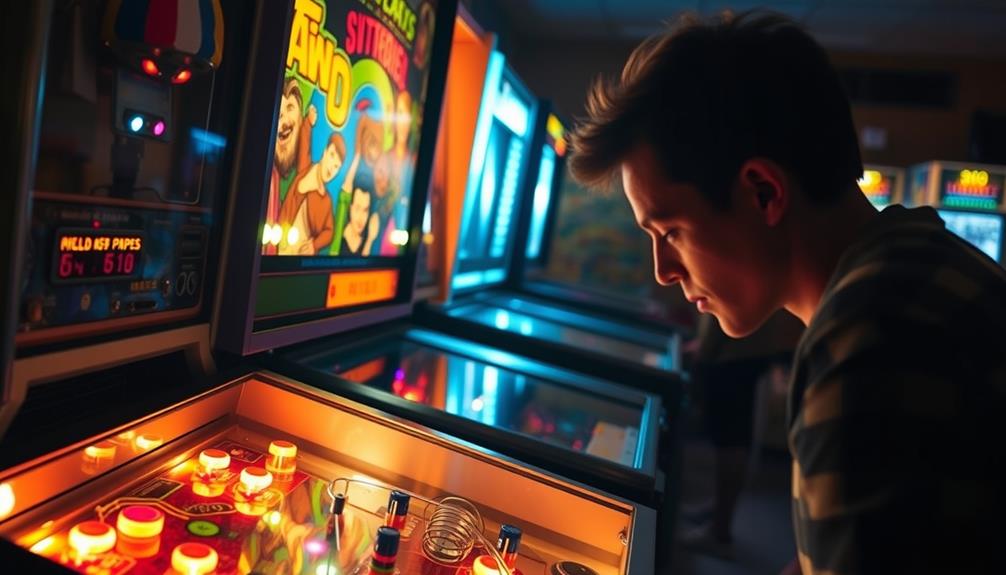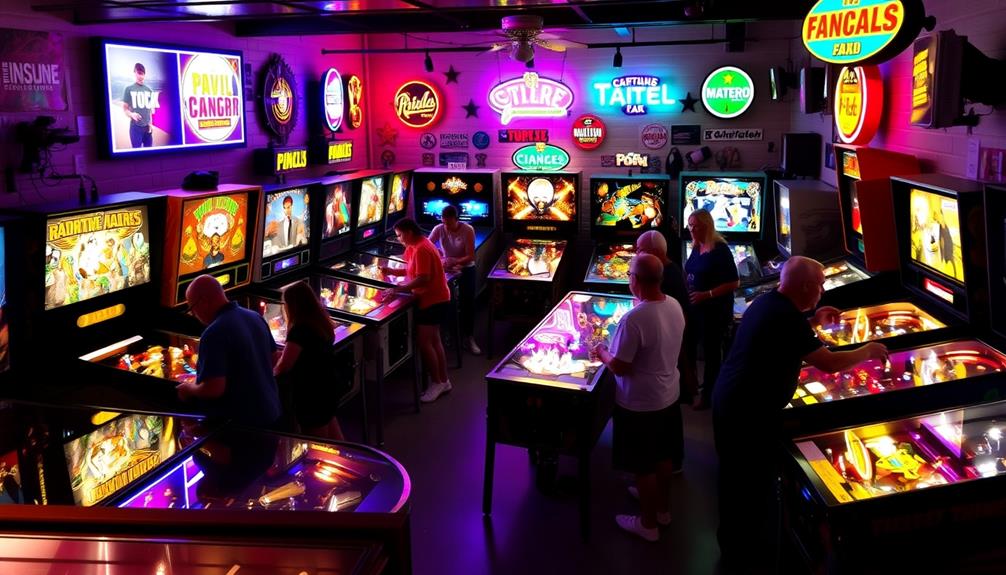The original text has been rephrased below:
The first electronic pinball machine, “Contact,” was introduced in 1933. This was a significant milestone in pinball history as it integrated electrical components into the game, replacing the previous reliance on mechanical mechanisms. Over the years, advancements in technology led to further enhancements such as sound effects and lights, ultimately culminating in the creation of the first solid-state electronic pinball machine, “Rally Girl,” in 1976. This new machine utilized advanced microprocessors, adding complexity and engagement to the gameplay. If you’re interested in learning more about the evolution of pinball machines and their impact on the gaming industry, there is a wealth of information to explore on this exciting journey.
Key Takeaways
- The first electronic pinball machine, Contact, was released in 1933.
- By 1934, electrical components were integrated into pinball machines, enhancing gameplay.
- The introduction of solid-state technology began in the 1970s, marking a significant evolution in pinball.
- Rally Girl, launched in 1976, was the first solid-state electronic pinball machine featuring advanced microprocessor technology.
- Solid-state machines replaced mechanical systems with microprocessors, revolutionizing pinball gameplay and scoring.
Origins of Pinball Machines
The origins of pinball machines trace back to the early 20th century, when innovators sought to combine elements of skill and chance in an enchanting arcade game. Initially inspired by the game of Bagatelle, these coin-operated pinball machines evolved rapidly.
By the 1930s, the first electromechanical pinball machines emerged, enhancing gameplay with features like sound effects from bells and buzzers. Bally's Bumper, released in 1937, introduced coil bumpers, marking a significant advancement in pinball mechanics and gameplay. Understanding the importance of diversification strategy in investments can also parallel the evolution of pinball machines, as manufacturers diversified features to attract players.
As the years went by, manufacturers began to incorporate lights and colored glass into their machines, dramatically improving their visual appeal.
The history of pinball machines took another leap forward in 1975 with the debut of Micro's Spirit of 76, the first solid-state electronic pinball machine. This revolutionary design utilized integrated circuits, paving the way for modern pinball. The history of pinball machines continued to evolve with the introduction of newer and more advanced technology. The transition to solid-state electronic systems marked a turning point in the history of pinball machines, leading to more complex and dynamic gameplay. This new era of pinball machines opened the door to a wide range of features and innovations that continue to shape the history of pinball machines today. The use of solid-state electronic systems also allowed for greater flexibility in designing pinball machine components. This led to the development of advanced features such as sound effects, digital scoring displays, and interactive lighting. These advancements continued to enhance the player experience and make pinball machines even more captivating and entertaining. As technology continues to evolve, pinball machine components are constantly being refined and improved to create the most immersive and engaging gameplay possible.
Today's machines boast advanced technology, including animatronics and interactive elements, making gameplay more immersive. So, whether you're a casual player or a pinball aficionado, understanding these roots enriches your appreciation for the enchanting world of pinball.
Transition to Electronic Gameplay

As you explore the evolution of pinball, you'll notice the shift from manual to electromechanical innovations in the early 1930s.
This pivotal change mirrors how design thinking fosters innovation in various fields, including gaming.
The introduction of solenoids and coil bumpers brought exciting new gameplay dynamics that transformed the player experience.
Early Electromechanical Innovations
In the early 1930s, pinball machines underwent a remarkable change with the introduction of electromechanical innovations that paved the way for electronic gameplay. The first electronically powered pinball machine, known as Contact, emerged in 1933, utilizing electromechanical solenoids for ball propulsion and introducing scoring sounds that enhanced player experience.
By 1934, manufacturers began incorporating electrical components, allowing for enhanced gameplay with vibrant lights and engaging sound effects. This evolution mirrors the themes of positivity and warmth found in uplifting music, as these innovations aimed to create a more enjoyable and immersive experience for players.
A notable leap came in 1935 with the introduction of the tilt mechanism, which improved gameplay integrity by preventing cheating. This innovation made players more accountable for their actions, adding a layer of strategy to the game.
In 1937, Bally's Bumper introduced coil bumpers, creating a dynamic shift in gameplay, as players could now experience unexpected ball movements and interactions.
These early electromechanical innovations set the foundation for the eventual change from mechanical to electronic gameplay. While the first solid-state electronic pinball machine, Spirit of 76, wouldn't arrive until 1975, the advancements of the 1930s laid the groundwork for a revolution in how players engaged with pinball, greatly enhancing the overall gaming experience.
Solid-State Technology Emergence
Frequently, players found themselves captivated by the evolution of pinball machines as solid-state technology emerged in the 1970s. The journey began with Harry Williams' first electronic pinball machine, "Contact," which introduced electromechanical solenoids and scoring sounds.
By 1934, manufacturers began integrating electrical components, enhancing gameplay experiences with lights and sounds. The introduction of coil bumpers in 1937, particularly with Bally's "Bumper," marked a significant shift in gameplay dynamics. This shift in technology paralleled the growing interest in alternative entertainment forms, much like the astrological charm that influences personal attraction.
However, it was in 1975 that solid-state technology truly revolutionized the industry with Micro's "Spirit of 76," the first solid-state electronic pinball machine. This marked a turning point, as microprocessors were introduced in the late 1970s, enabling more complex scoring and sound features.
Players were now treated to enhanced gameplay experiences, where the combination of electrical components and solid-state technology created a rich tapestry of interactivity. As you played, you could feel the difference—the responsiveness of the machines and the intricate gameplay dynamics kept you returning for more.
This shift not only modernized pinball but also set the stage for the future of arcade gaming.
The Launch of Rally Girl

Revolutionizing the pinball scene, the launch of Rally Girl in 1976 marked a pivotal moment in gaming history. As the first solid-state electronic pinball machine, it introduced a range of innovations that transformed the pinball industry.
Players could experience gameplay like never before, thanks to the advanced microprocessor that powered the machine, which allowed for more complex game mechanics, making it more engaging for players. Additionally, the excitement of playing pinball became akin to the anticipation of brewing the perfect coffee, as both activities offer a blend of skill and enjoyment different brewing methods.
Rally Girl replaced the traditional mechanical scoring systems with digital scoring, streamlining the way players tracked their progress. This shift not only enhanced the gameplay experience but also signaled a significant departure from electromechanical machines that had dominated the market.
With its electronic features, Rally Girl set the stage for future developments in pinball design, inspiring manufacturers to explore new possibilities.
The introduction of Rally Girl didn't just change the game; it marked the dawn of a new era in pinball. Players could now enjoy a more dynamic and interactive experience, paving the way for the rich, vibrant pinball culture that's recognized today.
Impact of Solid-State Technology

Solid-state technology fundamentally transformed the pinball landscape, ushering in an era of advanced gameplay and innovation. When the first solid-state electronic pinball machine, "Spirit of 76," launched in 1975, it marked a significant change from traditional electromechanical systems.
With solid-state technology, manufacturers replaced outdated relays and scoring reels with microprocessors, allowing for more complex gameplay mechanics. This shift parallels the advancements seen in AI-Powered Virtual Reality in E-Learning, where technology enhances user engagement and interaction.
This technological leap enhanced the player experience through digital displays and upgraded sound systems, providing richer audio-visual feedback during gameplay. You could now enjoy immersive soundtracks and vibrant visuals that brought the game to life.
Additionally, the implementation of solid-state electronics opened the door to intricate rule sets and multi-ball gameplay, increasing both the depth and replayability of pinball machines.
Evolution of Gameplay Mechanics

The evolution of gameplay mechanics in pinball machines has transformed how players interact with the game, making each session more engaging and dynamic. When the first electronic pinball machine hit the market, it introduced sound effects through electromechanical components, enhancing the gaming experience considerably.
By 1934, the addition of lights and colored glass boosted the visual appeal, drawing even more players in. The incorporation of these features parallels the benefits of raw food diets, which enhance nutrient absorption and promote better health, making experiences more vibrant.
The launch of Bally's Bumper in 1937 showcased coil bumpers, which propelled the ball upon contact, adding a new layer of excitement to gameplay.
Then, in 1947, Gottlieb's Humpty Dumpty introduced player-controlled flippers, turning pinball into a true game of skill. This allowed you to influence the ball's trajectory, making every shot count.
The transformation continued with Micro's Spirit of 76 in 1975, marking the shift to solid-state electronic pinball. This advancement brought about intricate game mechanics and allowed for more complex interactions.
The Resurgence of Pinball Culture

The Resurgence of Pinball Culture
As interest in retro gaming surged in the mid-2000s, pinball culture began to flourish once again. You might've noticed a wave of excitement around electronic pinball machines, as independent manufacturers emerged globally, revitalizing the market with innovative designs and themes.
Take Jersey Jack Pinball's release of "The Wizard of Oz" in 2013, for example. This resurgence not only brought fresh creativity but also showcased advanced technology, like LED displays and interactive elements that appeal to both new and seasoned players. This revitalization mirrors trends seen in unique party options that enhance celebrations, as enthusiasts seek out engaging and memorable experiences.
Competitive pinball tournaments have gained traction, fostering a vibrant community of enthusiasts who are dedicated to the preservation and enjoyment of the game. Online forums and social media groups enhance this experience, allowing players to share restoration techniques and celebrate pinball culture together.
With a tactile experience that stands apart from digital games, pinball has carved out a niche in the gaming landscape.
The combination of nostalgia and innovation guarantees that pinball remains relevant in modern entertainment. So, whether you're a casual player or a competitive enthusiast, there's never been a better time to plunge into the world of pinball.
Frequently Asked Questions
When Did Pinball Machines Go Digital?
Pinball machines went digital in the mid-1960s, starting with "Rally Girl" in 1966. This marked the shift from mechanical scoring to electronic displays, enhancing your gaming experience with better visuals and more engaging gameplay.
What Was the First Electric Pinball Game?
You'll find that the first electric pinball game, "Contact," emerged in 1933. With its solenoids buzzing like bees and sounds echoing through the arcade, it transformed gameplay, paving the way for future innovations.
What Was the First Licensed Pinball Machine?
The first licensed pinball machine you should know about is "The Wizard," released by Gottlieb in 1977. It brought vibrant artwork and electronic sounds, paving the way for future licensed machines based on popular culture.
When Was the First Electric Pinball Table With Flippers Released to the Public?
You might think pinball's always been about skill, but it wasn't until 1947, with Humpty Dumpty, that flippers changed everything. This innovation turned the game from chance to skill, revolutionizing player interaction and enjoyment.
Conclusion
To sum up, the journey of pinball machines from mechanical origins to electronic marvels is fascinating. Did you know that the first electronic pinball machine, "Rally Girl," was released in 1976? This innovation not only transformed gameplay but also sparked a resurgence in pinball culture. Today, enthusiasts celebrate over 1,000 different pinball machine designs, showcasing the game's enduring appeal. So, next time you hear the familiar sounds of flippers and bells, you'll appreciate how far it's come!









